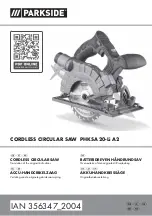
24
GAKS 350 E
EnGlISH
GB
e) Do not overreach. Keep proper footing and
balance at all times.
This enables better con trol of
the power tool in unexpected situations.
f) Dress properly. Do not wear loose clothing or
jewellery. Keep your hair, clothing and gloves
away from moving parts.
Loose clothes, jewellery
or long hair can be caught in moving parts.
g) If devices are provided for the connection of dust
extraction and collection facilities, ensure these
are connected and properly used.
Use of dust
collection can reduce dust-related hazards.
4) Power tool use and care
a) Do not force the power tool. Use the cor rect po-
wer tool for your application.
The correct power
tool will do the job better and safer at the rate for
which it was designed.
b) Do not use the power tool if the switch does not
turn it on and off.
Any power tool that cannot be
controlled with the switch is dan gerous and must
be repaired.
c) Disconnect the plug from the power source and/
or the battery pack from the power tool before
making any adjustments, changing accessories,
or storing power tools.
Such preventive safety
measures reduce the risk of starting the power tool
accidentally.
d) Store idle power tools out of the reach of child-
ren and do not allow persons unfamil iar with
the power tool or these instruc tions to operate
the power tool.
Power tools are dangerous in the
hands of untrained users.
e) Maintain power tools. Check for misalign ment or
binding of moving parts, breakage of parts and
any other condition that may affect the power
tool’s operation. If dam aged, have the power tool
repaired before use.
Many accidents are caused by
poorly main tained power tools.
f) Keep cutting tools sharp and clean.
Prop erly
maintained cutting tools with sharp cutting edges
are less likely to bind and are easier to control.
g) Use the power tool, accessories and tool bits etc.
in accordance with these instruc tions, taking into
account the working con ditions and the work to
be performed.
Use of the power tool for opera-
tions different from those intended could result in
a hazardous situ ation.
6) Service
a) Have your power tool serviced by a quali fied
repair person using only identical replacement
parts.
This will ensure that the safety of the power
tool is maintained.
c) Keep children and bystanders away while ope-
rating a power tool.
Distractions can cause you to
lose control.
2) Electrical safety
a) Power tool plugs must match the outlet. Never
modify the plug in any way. Do not use any
adapter plugs with earthed (grounded) power
tools.
Unmodified plugs and matching outlets will
reduce risk of electric shock.
b) Avoid body contact with earthed or grounded
surfaces, such as pipes, radia tors, ranges and
refrigerators.
There is an increased risk of electric
shock if your body is earthed or grounded.
c) Do not expose power tools to rain or wet condi-
tions.
Water entering a power tool will increase the
risk of electric shock.
d) Do not abuse the cord. Never use the cord for
carrying, pulling or unplugging the power tool.
Keep cord away from heat, oil, sharp edges or
moving parts.
Damaged or entangled cords incre-
ase the risk of electric shock.
e) When operating a power tool outdoors, use an
extension cord suitable for outdoor use.
Use of
a cord suitable for outdoor use reduces the risk of
electric shock.
f) If operating a power tool in a damp loca tion is
unavoidable, use a residual current device (RCD)
protected supply.
Use of an RCD reduces the risk
of electric shock.
3) Personal safety
a) Stay alert, watch what you are doing and use
common sense when operating a power tool. Do
not use a power tool while you are tired or under
the influence of drugs, alcohol or medication.
A moment of inattention while operating power
tools may result in serious personal injury.
b) Use personal protective equipment. Always wear
eye protection.
Protective equipment such as dust
mask, non-skid safety shoes, hard hat, or hearing
protection used for appropriate conditions will
reduce personal inju ries.
c) Prevent unintentional starting. Ensure the
switch is in the off-position before con necting to
power source and/or battery pack, picking up or
carrying the tool.
Carry ing power tools with your
finger on the switch or energising power tools that
have the switch on invites accidents.
d) Remove any adjusting key or wrench before
turning the power tool on.
A wrench or a key left
attached to a rotating part of the power tool may
result in personal injury.
Güde Elektro Ast- Kettensäge 95167_1.1.indd 24
08.02.12 16:50
Summary of Contents for 95167
Page 86: ...82 GAKS 350 E BG 3 RCD 30mA 1 2 Gu de Elektro Ast Kettensa ge 95167_1 1 indd 82 08 02 12 16 50...
Page 87: ...83 GAKS 350 E BG 4 5 6 Gu de Elektro Ast Kettensa ge 95167_1 1 indd 83 08 02 12 16 50...
Page 88: ...84 GAKS 350 E BG Gu de Elektro Ast Kettensa ge 95167_1 1 indd 84 08 02 12 16 50...
Page 90: ...86 GAKS 350 E BG ON OFF Gu de Elektro Ast Kettensa ge 95167_1 1 indd 86 08 02 12 16 50...
Page 105: ...101 GAKS 350 E Gu de Elektro Ast Kettensa ge 95167_1 1 indd 101 08 02 12 16 50...
Page 106: ...102 GAKS 350 E Gu de Elektro Ast Kettensa ge 95167_1 1 indd 102 08 02 12 16 50...
















































